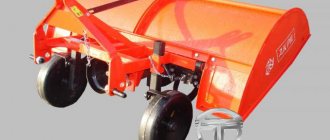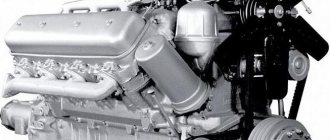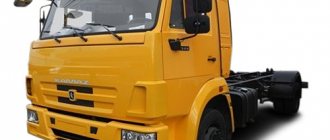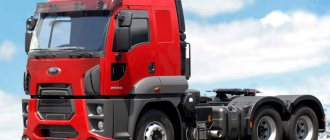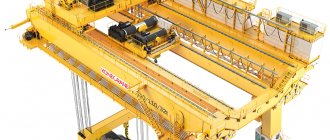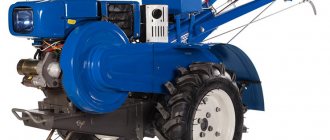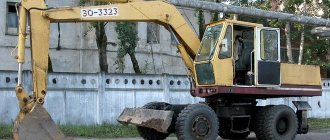Soil mill – refers to mounted agricultural devices used for tillage. The equipment is used in conjunction with tractors to crush the soil. It is used to process:
- heavy soils;
- virgin lands;
- long uncultivated fields;
- pastures.
By purchasing a soil tiller for cultivating fields, you can immediately solve several agricultural problems:
- significantly improve the properties of complex soils;
- increase their fertile capacity;
- promote a more uniform distribution of applied fertilizers;
- successfully control weeds;
- promote leveling of the soil surface;
- improve the penetration of moisture and air into the lower layers of fertile soil.
Considering the high efficiency of using rotary cutters , the reliability of their design and good maintainability, this is a good tool for use in agriculture.
What is a soil cutter?
The tiller has a very simple design, which guarantees its high reliability and long service life. It consists of a metal frame on wheels to which a horizontal shaft is attached. There is a row of metal blades on it, which, while the shaft rotates, cut the top layer of soil. It is driven by the tractor's power take-off shaft, to which a milling cutter is attached. There are some models that are driven through a chain drive.
The maximum working loads during operation of the rototiller are experienced by its blade discs. To prevent damage, knife blades are made of high-quality hardened steel. They provide the best soil development. To protect the shaft from contamination by clods of earth, a metal casing is attached to the frame.
Design Basics
With the advent of new technologies for tillage, the options for additional attachments for mini-tractors are increasing.
The leader in soil tillage accessories is the blade attachment, an ideal option with many possibilities. A mini-tractor with a rotary cutter is ideal for cultivating soil in greenhouses.
The soil cutter imitates manual digging with a shovel. Special “shovels” are installed on a shaft that constantly rotates, which, using a drive, plunge into the soil, lift it and transfer it. Most often, the width of the nozzle does not exceed 100–165 cm, and the working grip of these tools is 81–140 cm.
Additional equipment with a milling attachment can process virgin soil, hill up, form beds, and weed out
The most important purpose of any attachment with a milling cutter is to loosen the soil; such a tool is a special shaft with knives of different sizes
How to make a milling cutter for a mini tractor
Since the cost of a cutter is always sky-high, you can try to design an attachment with your own hands, especially since there is plenty of material on this topic on the Internet today, you can look at photo instructions, or you can pick up a video.
The cutter device consists of many blades, which can be made of steel sheet with a thickness of at least 12 mm, because the soil is most often heterogeneous. All components and connections must be installed with maximum rigidity, so special parts are needed. For example, the PK-1.6 pick-up stacker can be used as a gearbox. It is better to make the design of the cutter non-separable, but integral, so you can achieve strength in the nozzle.
The optimal speed for such a cutter should not exceed 4 km per hour. And the depth of surface treatment is usually regulated by skis. Knives can be made from KAMAZ springs; they will have to be turned on a machine. The cut knives must be installed on special connections. A homemade cutter made in this way will always operate at low speeds and will not turn the soil into dust. If you shave the right material for the design of your rototiller, then the blades for the minitractor rotary cutter will serve you for a long time and will not become dull.
Tilling the soil with a tiller is an energy-intensive process, so such attachments are used only when it is necessary to cultivate “heavy” soil. For example, soil that was flooded or, on the contrary, dried out. A side effect of the rotary cutter is the spraying of the soil, so the rotary cutter is not used on light and loose soil.
to the entry “Mill for a mini tractor: choose or make it yourself”
Good afternoon. If it `s not a secret. What drive is on the cardan of the cutter?
and the cutter turned out good, but there is simply nothing written about its production
Well done guys! I want to make it for myself! We need your sizes and comments on everything! Thanks in advance! My tel. 0664938689
Good afternoon. Is it possible to order this cutter for my Jinma 244 tractor? What is the price of the cutter and in what area is it located? Thank you
And drawings or sketches are mono
guys, you are just super well done, the question for you is what is the drive for the cardan, as I understand it, there is an L-shaped gearbox, can you buy it completely assembled as in the video, I also converted my walk-behind tractor into a minitractor, I would like to improve it, it has everything charging from a VAZ 2106 water sensors oils feet turns emergency lights hydraulics voltmeter and ammeter turning over the trailer in a word everything except connecting a mower with an outlet under the PTO help if you can thanks in advance
Please advise how to strengthen the soil on the Ft15dek mini tractor farmer
Please advise how to strengthen the right phrase on the farmer mini tractor FT15dek
The heart of any chainsaw is a two-stroke internal combustion engine.
The trimmer is not a complex household appliance, so most of it is not used.
There was a need to purchase a reliable and reliable mechanical assistant.
Gone are the days of Soviet agro-industrial megalomania. Gig disappeared.
A walk-behind tractor is an economical version of a tractor for small-scale work. .
In order to make such an attachment as a harrow with your own hands, in addition to ph.
Vertical tiller and its features
The design of vertical tillers uses disc blades that rotate around a vertical axis. To loosen the soil, straight knives are used, which fluff up the soil but do not turn it over. The advantages of vertical cutters include:
- the root system of agricultural plants develops better;
- agricultural yields increase by 10-15%;
In addition to the advantages, vertical tillers also have one drawback. During processing, mixing of soil layers does not occur. As a result, the distribution of applied fertilizer into the lower layers of the earth becomes significantly more complicated. Their maximum concentration remains only in the surface layer.
Vertical tillage of fields with appropriate tillers ensures:
- the formation of vertical channels in the soil through which a sufficient amount of air will be supplied;
- moisture reaches deeper layers, providing normal nutrition for plants with a developed root system;
- high-quality loosening of the soil - it contributes to the fact that the roots grow not to the sides, but in depth (such a root system provides plants with high stability in different climatic conditions);
- effective grinding of weeds;
- better grinding of plant residues and their root systems, which subsequently play the role of organic fertilizers.
Tillage cutter: design and technical requirements
Reliable milling technology must meet certain standards. It must be reliable and easy to operate, multifunctional, efficient, and economical. All these qualities are due to its design.
Design features of the tiller
The tillage cutter meets all the requirements for equipment intended for tillage.
The main design elements include:
- metal frame with a coupling device (for connecting to a tractor);
- a shaft with cutting knives (they can be of different shapes - sickle-shaped, rotary, chisel-shaped);
- drive (through it, rotation is transmitted to the working parts from the base device);
- fencing (performs a protective function).
The design is easy to maintain, durable and functional.
Technical requirements for tillers
General technical requirements are set out in interstate standards GOST-28516-90:
- Plowing depth should be up to 12 cm in plowed fields and up to 18 cm in unplowed fields.
- The degree of weed crushing should be at least 95 percent.
- The degree of soil loosening/crushing is at least 85 percent.
- The unevenness of tillage is no more than 15 percent.
- The use of cutters on terrain with a slope of no more than 8° in fields and no more than 12° in orchards and vineyards.
- Ease and simplicity of the tractor coupling mechanism (quick coupling or semi-automatic device).
- The dimensions of the clutch mechanism must comply with GOST 25942.
- The design of the cutters should allow adjustment of the rotation speed.
- Knives and fasteners must be made of materials established by GOST, have an anti-corrosion coating and comply with a certain strength class.
- Welds must be of high quality and free from flaws.
- There should be no lubricant leakage in connections and seals.
- Availability of drive and transmission protection equipment.
Compliance of the equipment with these requirements guarantees its reliable and safe operation. When purchasing equipment, you need to be very careful about this issue.
Horizontal tillers
In horizontal tillers, their blades rotate around a horizontal axis. In shape they resemble the Latin letter L. Working with such knives helps to better loosen the soil, making it softer and finer. Many plants are characterized by better formation of root crops on crumbly and soft soils. For such crops, the yield increases significantly after such treatment. Among the advantages of horizontal tillers, the following should be highlighted:
- simplicity of design, which ensures high reliability;
- long service life and good maintainability;
- possibility of parallel application of fertilizers to greater depths;
- improving soil saturation with air.
As for the disadvantages of horizontal models, they are associated with the design of the knife, which cuts weeds in a horizontal plane. There are a number of plants that reproduce by grinding their root system. New weeds grow from particles of chopped roots. Considering this factor, horizontal tillers cannot be used in fields where such weeds are found. In this case, it is better to process it with vertical cutters.
Plowing a walk-behind tractor with a plow
Experienced experts advise novice gardeners to begin their plowing work by stretching the cord along the first row. This simple procedure will make the furrow even.
When plowing other rows, the walk-behind tractor wheel will pass along the finished furrow of the first row. For this reason, all other furrows will be smooth; no additional measures are required.
In order to make plowing the garden convenient, the procedure must be carried out along a long row. This will help eliminate additional effort.
Plow adjustment
Plowing quality will not be good if the plow is not adjusted correctly. To ensure normal operation it is necessary:
Plowing depth
To achieve the required plowing depth, you need to pay attention to the weight of the walk-behind tractor. It is better to choose the one that is heavier. You can add weight yourself by attaching additional weights to the wheels.
The first furrow is made no more than 10 cm deep. You need to plow slowly and without putting pressure on the machine. If it happens that the equipment overheats, it is turned off for half an hour.
Very hard soil is easier to plow with a walk-behind tractor when wet.
Plowing with a plow
The main plowing should begin only after the trial version has been completed and all the shortcomings have been taken into account.
Two adjacent plowed strips should be spaced no more than 10 cm apart. Adjacent furrows should not cover one another with soil. The right wheel of the machine should be in the middle of the blade of the finished furrow, and not along its base.
By slightly increasing the speed, you can ensure that the surface of the plowing becomes smoother, without lumps. The plow makes it possible to make furrow depths of 15-20 cm.
You can plow the soil efficiently with a walk-behind tractor thanks to the high-speed mode. It is best when the walk-behind tractor has several gears so that the owner can choose the most convenient one for himself.
Features of the rototiller operation
A soil tillage cutter is an attachment used in conjunction with tractors. Its drive is provided by the power take-off shaft. The equipment to which the cutter is attached must be in full working order, and its power is sufficient to ensure efficient operation of the rototiller. Only those drivers who have been trained and know the intricacies of working with cutters are allowed to work.
Among the operating features of rototillers, the following should be highlighted:
- the cutter can only be used for its intended purpose, it is not suitable for any other tasks;
- connection to the tractor is carried out only with the engine turned off;
- When cultivating the field, you need to maintain optimal movement speed; if it is too high, there is a high probability of cutter failure; at low tractor speeds, the blades may become clogged and the quality of loosening will be unsatisfactory;
- soil cultivation is allowed only in the forward direction - the tractor moves forward, when moving in reverse, the cutter cannot be used;
- when turning, the cutter must rise; if this is not done, it may be seriously damaged;
- the driver is prohibited from approaching and inspecting the rotating cutter; other people must be at a safe distance from the tractor;
- In order to provide the necessary tractor power for working with a rototiller, fuel must be supplied in almost maximum mode.
- during operation, you need to monitor the condition of the cutter, it needs to be cleaned of adhering dirt; to prevent corrosion, it is recommended to lubricate the components of the rototiller with machine oil;
- If during the work the driver notices any malfunctions or extraneous noises, work must be stopped immediately and the working mechanism must be checked, observing safety rules.
Description
This type of attachment is quite common in the domestic agricultural market. Mostly, these are Russian and Belarusian units made in accordance with domestic quality standards.
FR-00010
I would like to start the description of the model range with FR-00010, manufactured at the Minsk Tractor Plant. It is clear that it is intended for MTZ mini tractors, but can also be mounted on other models that have a similar system for connecting attachments, for example Uralets, Kubota, Bulat 120, Yanmar, Belarus 132n, Scout.
FR-00010
This device can be used not only on light soils, but also on fairly heavy soil areas. It is allowed to use this cutter on slopes whose inclination does not exceed ten degrees.
Specifications:
- digging depth – up to 120 mm;
- width of the processed strip – from 440 to 610 mm;
- unit length – 65.5 cm;
- unit width – 68 cm;
- unit height – 47.5 cm;
- total weight – 47 kg;
- productivity on light soil – 0.18 hectares per hour;
- productivity on heavy soil – 0.12 hectares per hour;
- maximum speed – 3 km/h.
This cutter for a minitractor, the price of which will be about 24 thousand rubles, is intended for preliminary preparation of a land plot for its further use.
For more information about the operation of the FR-00010 cutter, watch the video:
FNM-1
FNM-1 is also produced in Belarus, like the previous model. It is used on a wide variety of soil types, but use on excessively inclined surfaces (up to ten degrees) is not allowed.
Specifications:
- digging depth – up to 80 mm;
- width of the processed strip – from 440 to 600 mm;
- unit length – 66 cm;
- unit width – 74 cm;
- unit height – 45 cm;
- total weight – 50 kg;
- productivity on light soil – 0.198 hectares per hour;
- productivity on heavy soil – 0.132 hectares per hour;
- maximum speed – 3 km/h.
1 GQN-125
1 GQN-125 is a fairly powerful model, so it has certain requirements for a mini tractor, or rather, for its power. Nominally, it should be from 24 to 30 hp. It can be used on a wide variety of land areas, from light to heavy soils.
GQN 125
Specifications:
- digging depth – up to 200 mm;
- width of the processed strip – up to 1250 mm;
- unit length – 90 cm;
- unit width – 100 cm;
- unit height – 135 cm;
- total weight – 220 kg;
- maximum speed – 4 km/h.
The cost of this cutter is about 32 thousand rubles. In addition, this is not the only representative of this line. In addition to this, there are quite a lot of models that differ from each other in the width of the strip they process. In this case, the serial number will be identical to the given width.
Maintenance of rotary cutters
In order for equipment to be in good working order and work efficiently, it needs to be serviced periodically. The following types of cutter maintenance are distinguished:
- monthly - it must be carried out immediately before the start of work, as well as after its completion;
- seasonal - they are performed twice a year; the first time when all field work is completed and the equipment is sent for off-season storage and the second time - before the start of spring field work, when the equipment is re-put into operation after being idle.
Benefits of plowing
Plowing is the main method of soil cultivation; it is aimed at improving the structure of the soil, increasing its fertility, saturating it with nutrients and preparing it for sowing. It is performed in the fall, after harvesting.
In the process of developing overgrown and marshy areas, the plow shows good results in the fight against weeds. Perennial weeds pulled out by the roots go deep and are tightly covered with a layer. Under such conditions, seeds do not germinate, and pathogens die.
The disadvantages of plowing include the fact that the passage of the plow is not considered a completed process of preparing the land, but only its first stage. After plowing, large lumps remain, so the area must be loosened and leveled.
Where to buy a rototiller?
The Agroimport company offers a large selection of various agricultural machinery at affordable prices. The company's catalog includes both horizontal and vertical tillers, the price and quality of which will pleasantly surprise you. Consumables and spare parts are always available for servicing cutters. Sending equipment is possible to any region of the country (we use the services of transport companies). For customers from the Krasnodar region, pickup from our warehouses is possible. All equipment and spare parts for it have a manufacturer's warranty.
Advantages of milling
Milling can be defined as loosening the earth. The advantage of a cutter over a plow is greater energy efficiency.
Advantages of soil milling:
After harvesting and removing the tops, the soil remains soft, so it can be milled without deep digging. After this, it is recommended to perform rolling to avoid rapid drying and compaction of low-humus, structureless soils. This method of site preparation can be used when autumn planting of green manure, winter garlic and other crops is planned.
Some weeds cannot be dealt with by a conventional tiller. This applies to wheatgrass, horseradish and similar plants. The cutter crushes the rhizomes of these plants and promotes their spread. Therefore, it is optimal to plow the area with a plow with a rotation of the layer in order to embed the weeds as deeply as possible and press them down with a layer of soil in order to avoid their germination.
Summarize. To determine the appropriate tillage method, consider the type of soil and your material equipment. In small areas, you can do without autumn plowing and use a motor cultivator for spring cultivation. In large and medium-sized farms, you need to choose the most suitable method. Most often this is autumn plowing and spring milling.
Source
Advantages of milling
Milling can be defined as loosening the earth. The advantage of a cutter over a plow is greater energy efficiency.
Advantages of soil milling:
After harvesting and removing the tops, the soil remains soft, so it can be milled without deep digging. After this, it is recommended to perform rolling to avoid rapid drying and compaction of low-humus, structureless soils. This method of site preparation can be used when autumn planting of green manure, winter garlic and other crops is planned.
Some weeds cannot be dealt with by a conventional tiller. This applies to wheatgrass, horseradish and similar plants. The cutter crushes the rhizomes of these plants and promotes their spread. Therefore, it is optimal to plow the area with a plow with a rotation of the layer in order to embed the weeds as deeply as possible and press them down with a layer of soil in order to avoid their germination.
Summarize. To determine the appropriate tillage method, consider the type of soil and your material equipment. In small areas, you can do without autumn plowing and use a motor cultivator for spring cultivation. In large and medium-sized farms, you need to choose the most suitable method. Most often this is autumn plowing and spring milling.
Source
Benefits of plowing
Plowing is the main method of soil cultivation; it is aimed at improving the structure of the soil, increasing its fertility, saturating it with nutrients and preparing it for sowing. It is performed in the fall, after harvesting.
In the process of developing overgrown and marshy areas, the plow shows good results in the fight against weeds. Perennial weeds pulled out by the roots go deep and are tightly covered with a layer. Under such conditions, seeds do not germinate, and pathogens die.
The disadvantages of plowing include the fact that the passage of the plow is not considered a completed process of preparing the land, but only its first stage. After plowing, large lumps remain, so the area must be loosened and leveled.
Types of device
Knives for a mini tractor cutter are the main working element. They are made of durable steel with a thickness of at least 10 mm. Equipment is classified according to the shape and method of making knives.
According to the shape of the knives, they are distinguished:
- Saber-shaped ones are the most popular type of rototiller knives. They effectively “cut” earthen clods and thin roots and mix the earthen layer. Safe - if there are stones in the ground, the knives pick them up, throw them away and continue working further.
- Crow's feet are effective when used on clay or virgin soil. However, they are not very durable and require frequent repairs if used intensively.
Based on the material and manufacturing technology, they are distinguished:
- Stamped with a weakly defined cutting edge - suitable for light and well-cultivated soils, included in the package of inexpensive tractors and walk-behind tractors.
- Forged self-sharpening - effective when working with heavy or complex soils, durable and reliable, pay for themselves over long and intensive use.

